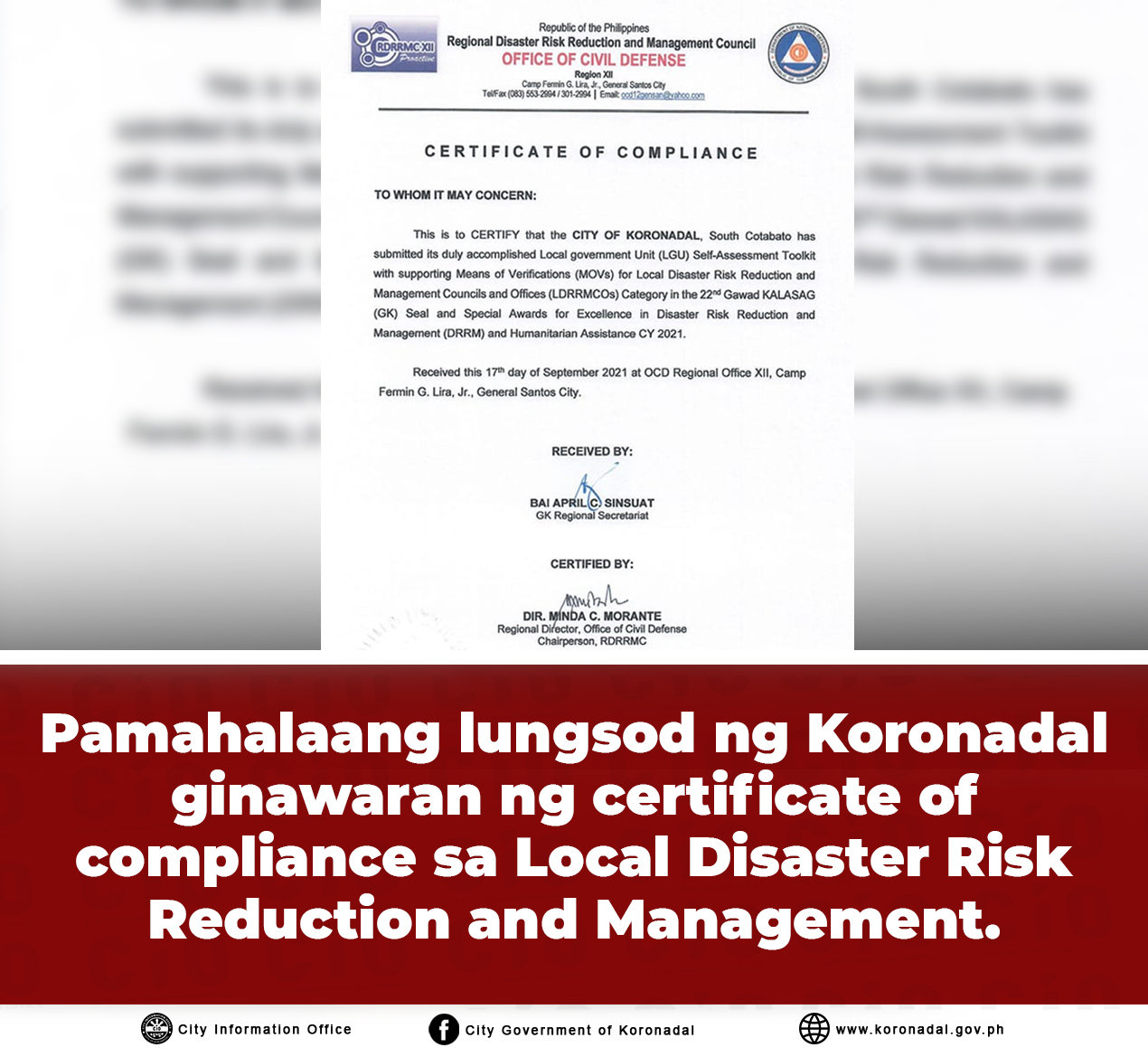A pandemic cannot hamper disaster preparedness

Koronadal City government has once again proven that pandemics cannot hamper disaster preparedness following its receipt of the certificate of compliance awarded by the Office of the Civil Defense (OCD) Region XII through the City Disaster Risk Reduction and Management Council Office (CDRRMO).
Based on the self-assessment carried out by the Regional Disaster Risk Reduction and Management Council (RDRRMC), the city has passed the functionality of the Local Disaster Risk Reduction and Management Council and Office (LDRRMCO) according to the specified requirements and complied with National Disaster Risk Reduction and Management Council (NDRRMC) by the award-winning body Gawad Kalasag (GK).
CDRRMO Cyrus Jose Urbano enumerated the checklists on the assessment of the functionality of the LDRRMO which is composed of five (5) areas that comprise different sub-concerns such as:
1.1. Creation of LDRRMO;
1.2. LDRRMO staffing/personnel complement;
1.3. Local DRRM Officer that comprises of appointment, competency, educational attainment, eligibility, updated pieces of training, seminars and for an attended.
2.1. Designing, Programming and Coordination of DRRM activities;
2.2. Facilitation and support to risk assessment and contingency planning;
2.3. Consolidation of local disaster risk information and maintenance of local risk maps;
2.4. Database of critical infrastructures;
2.5. Recommendations to enact DRRM-related ordinances through the LDRRMC;
3.1. Organization and Conduct of pieces of training, orientation and knowledge management activities on DRRM at the local level;
3.2. Information dissemination and public awareness campaigns on hazards, risks, their nature, effects and counter-measures;
3.3. Suitably-trained and competent personnel for effective civil defence and disaster risk reduction and management;
4.1. Operation of multi-hazard early warning system to provide accurate and timely advice to national or local emergency response organizations and the general public;
4.2. Networking with the private sector, civil society organizations and volunteer groups;
4.3. Respond to and manage the adverse effects of emergencies/disasters and carry out recovery activities in the affected area, ensuring that there is an efficient mechanism for immediate delivery of basic needs especially for the women and children;
4.4. Establishment of linkage/network with other LGUs for emergency and disaster response activities;
4.5. Establishment of Provincial/City/Municipality DRRM operation center.
5.1. Establishment of LDRRMC
5.2. Convention of LDRRMC once every three (3) months or as necessary;
5.3. Approve, monitor and evaluate the implementation of LDRRMPs and regulatory review and test the plan consistent with other national and local planning programs;
5.4. Ensure the integration of risk reduction and climate change adaptation into local development plans and budgets as the strategy in sustainable development and poverty reduction;
5.5. Programming and budgeting for LDRRMC and other DRRM resources;
5.6. Recommendation to enact DRRM-related ordinances through the LDDRMC.
“Ang makabaton sang certificate of compliant ang isa ka dako nga dungog tungod sa kabudlay sang mga criteria kag very comprehensive”, Urbano said while expressing his gratitude to the people behind the success after they seem to have gone through the needle just to obtain the aforementioned certificate.
He stated further that their office had presented a bunch of pictures and documents as Means of Verification (MOVs) to the evaluators as proof of the activities being conducted aside from the field validation performed by the assessors.
The inspection was carried out by a team made up of regional offices including the Department of Health (DOH), Bureau of Fire (BFP), Department of Social Welfare and Development (DSWD), Department of Interior and Local Government (DILG) and OCD.
Urbano also clarified that the assessment conducted is not a competition but it is a source of pride that an LGU should has as a confirmation of the interventions undertaken in preparation for any disaster.